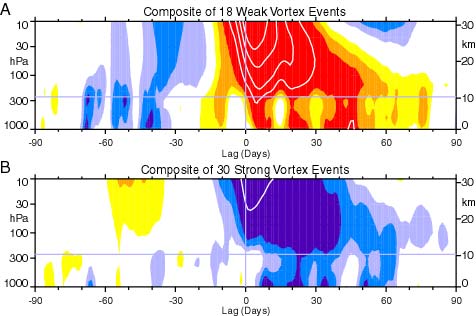Stratosphere-Troposphere Coupling
Current stratospheric conditions:
Zonal means ECMWF (FU Berlin)
30 hPa map ECMWF (FU Berlin)
Met. Office & Brit. Atmos. Data Centre (A. Charlton)
Vertical cross section AO (NOAA-CPC)
Vertical cross section AAO (NOAA-CPC)

Fig. 1. Observed composites of time-height development of the northern annular mode for (A) 18 week vortex events and (B) 30 strong vortex events. (From: Baldwin, M. and T. J. Dunkerton (2001): Science V 294.)
The dynamical mechanisms by which stratospheric circulation anomalies can influence the troposphere are poorly understood, and most current numerical models for weather or climate do not include a well-resolved stratosphere. The objective of my current research is to better understand the role of the stratosphere for tropospheric weather and climate with a numerical model that specifically resolves middle atmospheric dynamics. We use a dry hydrostatic primitive equation model of the troposphere-stratosphere system to conduct sensitivity experiments to transient forcings. The use of this relatively simple model allows the careful examination of the mechanisms that control the wave flux into the stratosphere as well as the downward propagation following major stratospheric circulation anomalies. In a first approach we investigate the response of the model to transient wave activity flux from the troposphere.
Observations indicate that the eddy heat flux at the tropopause correlates well with the zonal mean winds in the middle stratosphere, indicating that stratospheric anomalies are controlled by anomalous wave activity fluxes from the troposphere. It is unclear, however, whether the stratosphere simply responds to upward wave activity fluxes from the troposphere, or actually modulates such wave activity fluxes. In our model experiments, pulses of upward propagating planetary waves are created by prescribing a time varying bottom topography to the model at the beginning of the simulation. The waves break in the stratosphere and lead to zonal wind anomalies also known as stratospheric warming events (Animation). This experimental setup allows us to create controlled stratospheric circulation anomalies and to investigate their subsequent downward propagation into the troposphere (Fig. 2).
Animation: Stereographic view of the evolution of the potential vorticity (PV) field in response to a topographic perturbation from day 0-10. Shown is PV on the 950-K potential temperature surface, corresponding to a pressure of about 5 hPa. The North Pole is in the center of the picture. Units are in potential vorticity units. Time steps in hourly increments from day 0 out to day 100.
The results can be used to understand the sensitivity of the stratosphere to tropospheric wave activity flux, to find out the optimal conditions for the creation of sudden warmings, and to investigate the nature of the subsequent tropospheric response. It will be particularly interesting to compare the results with those from unforced simulations, and to find out how important antecedent tropospheric wave forcing is for the subsequent downward propagating of circulation anomalies. Preliminary results indicate that the timing of the downward response is controlled by (1) initial anomalies in the stratospheric polar vortex, and (2) by the initial strength of the lower stratospheric eddy drag. These two criteria are found to be sufficient to predict the surface response of the stratosphere-troposphere system 30 to 100 days after application of the forcing.

Fig.
2. Time-height development
of standardized geopotential height anomalies over the polar cap (60-90N,
0-360E). Shown is the ensemble mean of 20 transient experiments. The
experiments were forced with a simple topographic forcing over 10 days to
generate upward propagating planetary waves. The waves break in the
stratosphere and produce anomalies, which then propagate downward and can
be detected in the troposphere at lags of 30-100 days.
This page has been visited
[an error occurred while processing this directive]
times since Friday, 31-Oct-2008 16:26:29 MDT